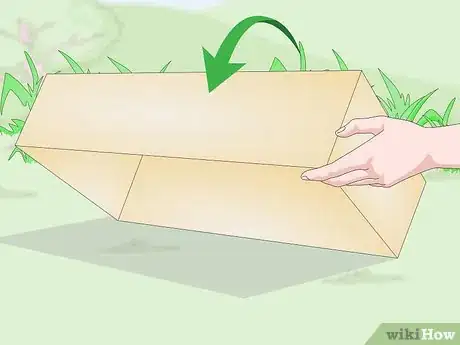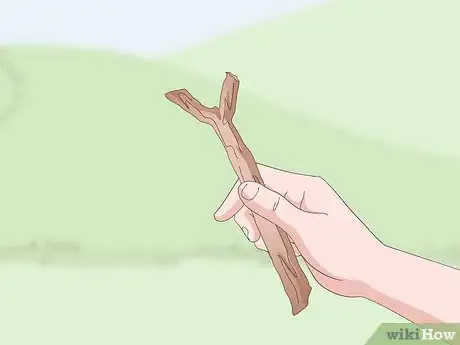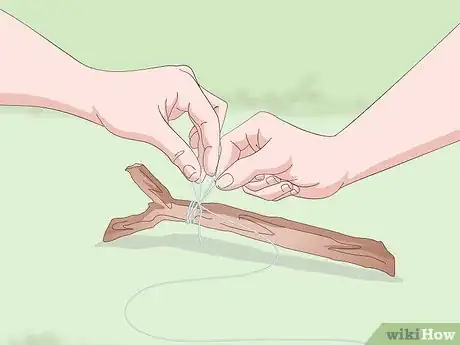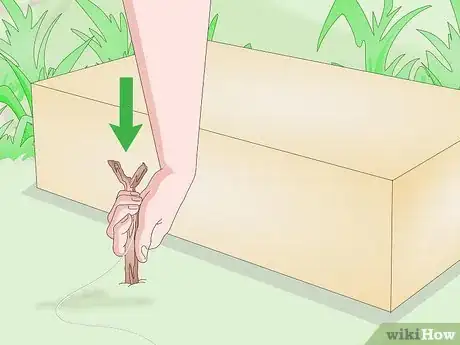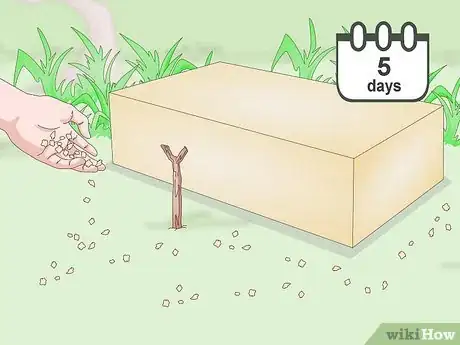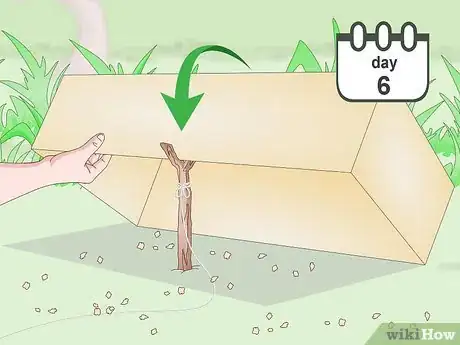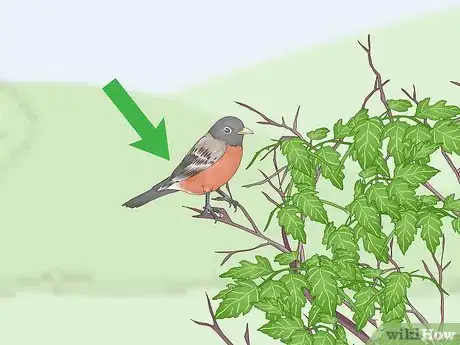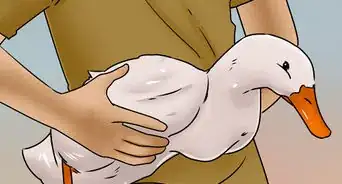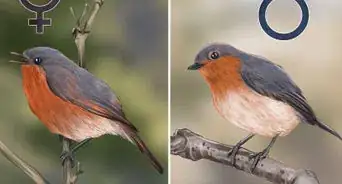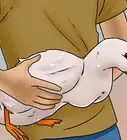X
This article was co-authored by wikiHow Staff. Our trained team of editors and researchers validate articles for accuracy and comprehensiveness. wikiHow's Content Management Team carefully monitors the work from our editorial staff to ensure that each article is backed by trusted research and meets our high quality standards.
This article has been viewed 33,645 times.
Learn more...
American robins are distinguished by their large, round bodies, dark heads, and orange underparts. If you want to catch a robin to improve your bird trapping technique—or just for fun—you can create a simple trap from a stick and box. Just make sure you do not keep the robin as it is illegal to keep trapped birds in most areas of the world.
Steps
Method 1
Method 1 of 2:
Catching a Robin
-
1Put a lidless rectangular box outside with the open end down. Any kind of rectangular box without a lid works. Ideally, it should be about 8.5 by 10 inches (22 cm × 25 cm) in size. After you have your box, head outside and place it open-end down in a robin-friendly area.[1]
- Be sure to place your box in an area with dirt that's soft enough to dig at least 1 inch (2.5 cm) deep into it.
-
2Find a Y-shaped branch from a backyard tree. Head to your backyard or a local park and look for a Y-shaped branch. Now, break off the branch at point 5 inches (13 cm) down from the "V" along the straight branch.[2]
- If you're having trouble breaking the branch with your hands, use a handsaw.
Advertisement -
3Wrap a fishing line to the top of the branch. Take a 15 foot (4.6 m) fishing wire and wrap it around the top of the Y-shaped branch at the point where the 2 diagonal branch pieces meet the straight branch. Be sure to tie a tight knot.[3]
- Give the fishing line a quick tug after tying the knot to make sure that it's securely tied to the branch.
-
4Insert the Y-shaped branch into the dirt in front of the box. Insert the pointed side of the Y-shaped branch about 1 inch (2.5 cm) deep into the dirt. Position it directly in front of the box and make sure to position it so it's half the width of the box away from it.[4]
- For example, if the box is 3 feet (0.91 m) long, position the branch 1.5 feet (0.46 m) away from the box.
-
5Sprinkle bread crumbs around the box daily for 5 days. Each day, head to the box and spread 1 handful of breadcrumbs around it. Continue doing this each day for 5 consecutive days.[5]
- Try to sprinkle your crumbs evenly around the box in a circle.
- Be sure to leave your Y-shaped branch in front of the box during the 5 days that you sprinkle bread crumbs.
- Don't worry about staying and watching the birds after sprinkling the bread crumbs during the first 5-day period.
-
6Lift the box onto the Y-shaped branch on day 6. When you go to sprinkle the breadcrumbs on the 6th day, it's time to set the trap. Lift the wide end of the box that's closest to the branch, then balance that end on the intersection of the Y-shaped branch. Afterwards, sprinkle breadcrumbs around and under the box.[6]
- Check that the opposing width side of the box is resting flat on the ground. If it isn't you won't be able to align the box perfectly on the branch.
- Sprinkle 1 handful of breadcrumbs around the box and 1 handful underneath the box. Try to sprinkle the first handful of breadcrumbs evenly in a circle around the box.
-
7Hold the fishing wire while hiding from view. With the box elevated and your breadcrumbs spread, your trap is set! Grab the untied end of the fishing line and find a door or tree to hide behind.[7]
- If you can't find anywhere to hide, stand back as far from the box as possible and remain still and quiet.
-
8Pull the fishing wire when the robin goes under the box. Observe the robins in the area as they feed and remain as motionless and quiet as possible. Once you see a robin go under the box to the breadcrumbs, tug on the wire quickly to bring the box down and trap it.[8]
- Don't pull the wire too soon! Always wait for the robin to move from eating the outside breadcrumbs to eating the breadcrumbs under the box.
Advertisement
Method 2
Method 2 of 2:
Spotting a Robin
-
1Head to city parks, fields, and wild habitats to find robins. Robins are common in fields, lawns, city parks, as well as wild habitats such as forests, woodlands, and mountains. In wild habitats, they are often found up to tree lines, tundra, and recently burned forests.[9]
- Robins tend to inhabit areas with insects, earthworms, and select snails.
- During the winter, lots of robins relocate to moist woods to find shrubs and trees that produce berries.
- Look for areas with ample amounts of fruit, such as hawthorn, dogwood, chokeberries, juniper berries, and sumac fruits.
-
2Look for birds with round bodies, long legs, and a long tail. In the category of North American thrushes, robins are the largest. They are double the size of bluebirds and can be easily distinguished by their large, round shape.[10]
- Both male and female robins are between 7.9 to 11 inches (20 to 28 cm) long. Their wingspans are 12.2 to 15.8 inches (31 to 40 cm).
- The average robin weight is 2.7 to 3 ounces (77 to 85 g).
-
3Watch for gray-brown birds with dark heads and orange underparts. If you spot these colors, you've probably found robins. When you're looking for robins in the sky, look for a white spot under the tail and on the lower belly.[11]
- Female robins have paler heads, which don't contrast as strongly with their gray backs as they do in males.
-
4Search for robin nests on 1 or more horizontal branches near dense layers of leaves. Nests are often either hidden in these layers or located just below them. They are often created in the lower half of trees, but sometimes you will find them as high up as the top of the tree. On average, they are 6 to 8 inches (15 to 20 cm) across and 3 to 6 inches (7.6 to 15.2 cm) high.[12]
- Look for American robin nests in eaves, gutters, and outer light fixtures.
- If you live in the western prairies, look for American robins in thickets or on the ground. If you live in Alaska, they also nest on cliffs and buildings.
- Nests are most commonly made from twigs and dead grass. In addition, they are made from feathers, paper, moss, and rootlets.
Advertisement
Community Q&A
-
QuestionWill the bird die when I catch it?
 Community AnswerIf you're careful, then no, a robin will not die if you catch it.
Community AnswerIf you're careful, then no, a robin will not die if you catch it. -
QuestionHow do I catch the robin without a net?
 Community AnswerYou could try using a sheet. It could act in the place of one. However, you would need some way to extend it without having to get too close to the bird, as you might scare it.
Community AnswerYou could try using a sheet. It could act in the place of one. However, you would need some way to extend it without having to get too close to the bird, as you might scare it. -
QuestionWhat if the bird gets away?
 Community Answer"Don not keep any robins that you catch. In many states it is illegal to keep trapped birds. Catch and release her ASAP to avoid any legal troubles." It's fine if it gets away. You're supposed to let it go anyway. If you want to try trapping another, you can try again.
Community Answer"Don not keep any robins that you catch. In many states it is illegal to keep trapped birds. Catch and release her ASAP to avoid any legal troubles." It's fine if it gets away. You're supposed to let it go anyway. If you want to try trapping another, you can try again.
Advertisement
Things You'll Need
- Bread crumbs
- Cardboard box without the lid
- Y-shaped branch 5 inches (13 cm) long
- Fishing line 15 feet (4.6 m) long
Warnings
- Remember that wild birds can carry diseases and mites.⧼thumbs_response⧽
- Do not keep any robins that you catch—in many areas of the world, it is illegal to keep trapped birds.⧼thumbs_response⧽
Advertisement
References
- ↑ https://animals.mom.me/how-to-build-a-robin-trap-12294435.html
- ↑ https://animals.mom.me/how-to-build-a-robin-trap-12294435.html
- ↑ https://animals.mom.me/how-to-build-a-robin-trap-12294435.html
- ↑ https://animals.mom.me/how-to-build-a-robin-trap-12294435.html
- ↑ https://animals.mom.me/how-to-build-a-robin-trap-12294435.html
- ↑ https://animals.mom.me/how-to-build-a-robin-trap-12294435.html
- ↑ https://animals.mom.me/how-to-build-a-robin-trap-12294435.html
- ↑ https://animals.mom.me/how-to-build-a-robin-trap-12294435.html
- ↑ https://www.allaboutbirds.org/guide/American_Robin/lifehistory
About This Article
Advertisement
